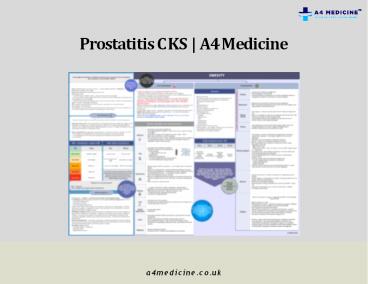Prostatitis CKS | A4 Medicine - PowerPoint PPT Presentation
Title:
Prostatitis CKS | A4 Medicine
Description:
Prostatitis describes a combination of infectious diseases ( acute or bacterial prostatitis ) chronic pelvic pain syndrome and asymptomatic inflammation ( Krieger et al 2008 ) – PowerPoint PPT presentation
Number of Views:14
Title: Prostatitis CKS | A4 Medicine
1
Prostatitis CKS A4 Medicine
2
Prostatitis CKS describes a combination of
infectious diseases chronic pelvic pain syndrome
and asymptomatic inflammation
( acute or bacterial prostatitis ) ( Krieger et
al 2008 )
Prevalence is high , comparable to rates of IHD
and diabetes Third most important condition of
the prostate AAFP reports prevalence of 8.2 (
range from 2.2 to 9.7 ) Rosebud et al quote a
prevalence of 5 to 9 among unselected men in
the community The lifetime probability of a man
being diagnosed as prostatitis exceeds 25 and
prostatitis accounts for about 25 of men
seeking medical attention for genitourinary
complaints.
3
Type 1 or Acute bacterial prostatitis acute
infection of the prostate / urinary tract
infection can be medical emergency with severe
symptoms , systemic upset true incidence is not
known but it is estimated that this may
constitute about10 of all cases of
prostatitis. Type II Chronic bacterial
prostatitis persistent bacterial infection of the
prostate gland causing recurrent UTIs caused by
the same strain of bacteria duration gt 3
months. Type IIIChronic prostatitis/chronic
pelvic pain syndrome most common subtype no
identifiable infection further subdivided into ?
Type A inflammatory CPS previously known as
chronic non bacterial prostatitis? Type B non
inflammatory CPS previously called
prostatodynia Type IV asymptomatic inflammatory
prostatitis no symptoms but documented
inflammation in prostatic tissue abnormal semen
analysis , elevated PSA or incidental finding of
prostatitis on examination of a biopsy specimen
4
What causes prostatitis is a matter of ongoing
debate Multiple etiologies both infectious
non-infectious Some cases clearly infectious
Majority of cases have no evidence of
genitourinary infection and the cause is usually
not known Risk factors include ? genetic,
behavioral and environmental factors ?
inflammatory mediators ? urinary tract
instrumentation ? men with chronic indwelling
catheters ? diabetes ? cirrhosis ? a h/o
sexually transmitted infections ? having a
urethral stricture Acute bacterial prostatitis
Acute prostatitis is used interchangeably with
acute acute bacterial prostatitis ( ABP ) in
literature NICE in its draft for consultation (
May 2018 ) mentions that ? acute prostatitis is
a bacterial infection of the prostate needing
treatment with antibiotics ? usually caused by
bacteria which enter the prostate from the
urinary tract ? ABP can happen spontaneously or
after medical procedures as prostate biopsy ? it
can last for several weeks ? complications
include urinary retention prostatic abscess
ABP can be a life threatening event requires
prompt recognition and treatment.
5
First choice -Ciprofloxacin 500 mg bd X 14 days
Ofloxacin 200 mg bd x 14 days Alternative 1st
choice -Trimethoprim 200 mg bd x 14 days Second
choice -Following discussion with
specialist Levofloxacin 500 mg od x 14
days Co-trimoxazole 960 mg bd x 14
days. Fluoroquinolones consider restrictions
and precautions as per MHRA advice ? rare
reports of disabling potentially long-lasting
irreversible SEs of musculoskeletal and nervous
systems ? advice to stop at 1st sign of serious
adverse reaction such as tendonitis ? prescribe
with special caution in over 60s ? avoid
co-administration with a corticosteroid Co-trimox
azole only use if there is bacteriological
evidence of sensitivity good reasons to prefer
this combination. Review if symptoms worsen and
consider ? alternative diagnoses ? complications
as acute urinary retention , prostatic abscess
or sepsis ? antibiotic resistance Following 2
week antibiotic use ? stop or continue for
additional 14 days if needed based on history ,
symptoms , clinical examination , urine and blood
tests. Chronic bacterial prostatitis -Symptoms
persist gt 3 months CBP most common
presentation is recurrent urinary tract infection
from the same organism Rees et al report that
the pain is a predominant symptom of both CBP and
CP/ CPPS with the four main symptoms domains of
CBP Cp/ CPPS being ? urogenital pain (perineal
, inguinal , suprapubic , scrotum , testis ,
penile tip , lower back , rectum ) ? lower
urinary tract symptoms ( LUTS ) ? psychological
issues ? sexual dysfunction CBP can be a
complication of ABP in about 5 of men About 10
of CP have a bacterial cause.
6
- Cause -ascending urethral infection lymphogenous
spread of rectal bacteria hematogenous spread of
bacteria from a remote source undertreated acute
bacterial prostatitis recurrent UTI with
prostatic reflux. - Pathogens -similar to ABP E Coli responsible for
majority of cases other identified pathogens
include Chlamydia trachomatis , Ureaplasma
species , Trichomonas vaginalis and
Mycobacterium tuberculosis. - Diagnosis -Can be challenging as history and
examination can be highly variable. - Meares-Stamey ( 1968 ) four glass test- finds
mention in most papers as being gold standard
but nor rarely used Urinalysis Expressed
prostatic secretions culture Semen culture
Further testing based on clinical suspicion for
e.g PSA , STI screen , cystometric studies. - Treatment -can be difficult includes trial of
antibiotics , alpha adrenergic agents for
refractory cases options tried include ?
alternative agents as fosfomycin ? direct
antimicrobial injections into the prostate ?
surgical removal of infected prostate tissue - chronic oral antibiotic suppression ? novel
therapies as utilizing bacteriophages to - target antibiotic resistant bacteria.
- Complex condition of largely unknown cause
usually diagnosis of exclusion.































